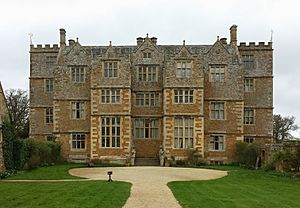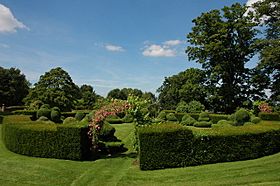Chastleton House facts for kids
Quick facts for kids Chastleton House |
|
|---|---|

Front elevation
|
|
| Type | Country house |
| Location | Chastleton, Oxfordshire |
| Built | 1607–12 |
| Architect | attributed to Robert Smythson |
| Architectural style(s) | Jacobean |
| Owner | National Trust |
|
Listed Building – Grade I
|
|
| Official name: Chastleton House | |
| Designated | 15 December 1954 |
| Reference no. | 1197988 |
| Lua error in Module:Location_map at line 420: attempt to index field 'wikibase' (a nil value). | |
Chastleton House is a beautiful old country house in Chastleton, Oxfordshire, England. It was built a long, long time ago, during a period called the Jacobean era. Since 1991, the house has been looked after by the National Trust, a charity that protects historic places. It's also a Grade I listed building, which means it's a very important historic site.
Contents
A Glimpse into History
Chastleton House was built between 1607 and 1612. It was likely designed by Robert Smythson for a man named Walter Jones. Walter Jones was a lawyer who became very wealthy. He bought the land in 1602. The house is made from Cotswold stone and has a small central courtyard.
A Brave Wife During the English Civil War
Chastleton House is famous for a story from the English Civil War. This war was fought in England between 1642 and 1651. It was between those who supported King Charles I (called Royalists) and those who supported Parliament (called Roundheads).
The story tells of Arthur Jones, a grandson of Walter Jones. Arthur was a Royalist who fought for King Charles II. In 1651, after a big battle, Arthur galloped back to Chastleton. Soldiers who supported Parliament were chasing him.
Arthur's clever wife, Sarah, quickly hid him in a secret room above the porch. The soldiers found Arthur's tired horse in the stables but couldn't find him. Sarah saved her husband by giving the soldiers beer mixed with a sleeping medicine. While they slept, she got one of their horses ready for Arthur to escape.
The House Through the Years
The Jones family owned Chastleton House for almost 400 years! In 1874, Mary Whitmore Jones inherited the house. She was the first woman in her family to own it. Mary was a writer and also designed a special board game called the Chastleton Patience Board.
Later, the house was passed down through other family members. The National Trust took over in 1991. They decided to keep the house mostly as it was, rather than completely restoring it. This way, visitors can see it almost exactly as the family left it.
Exploring Chastleton House
Chastleton House is special because it's different from many other large houses of its time. It doesn't have a huge, landscaped park leading up to it. Instead, it was built right within Chastleton village. The village provided many services for the house, like a laundry and a place to bake bread.
Inside the House
Many rooms in Chastleton House are open for visitors to explore.
The Long Gallery
One amazing part of the house is the Long Gallery. It has a long, curved ceiling that looks like the inside of a barrel. This room is about 72 feet (22 meters) long. It's a great example of how grand houses were built back then. Over the years, parts of the ceiling were damaged, but they were carefully repaired.
The Great Chamber
Another impressive room is the Great Chamber. This room was used to entertain important guests and for playing music. Its design was inspired by art from Renaissance Italy. The walls have beautiful wooden panels, and there are painted pictures of prophets and prophetesses around the top.
In the Great Chamber, you can also see special glasses engraved with symbols like roses and oak leaves. These symbols were used by people who supported the Jacobite cause in the 1700s. The Jones family likely supported this cause.
The Juxon Bible
The house also holds the Juxon Bible. It's believed that this Bible was used by a chaplain named William Juxon when King Charles I was executed. William Juxon later became a very important church leader. His family lived nearby, and the Bible was given to the Jones family because they shared similar beliefs.
Historic Tapestries
In 1919, some important tapestries (large woven pictures) were found at Chastleton House. One of these tapestries is now on display in the Middle Chamber, and another is in a museum in London.
The Gardens of Chastleton
The gardens at Chastleton are also very old and have changed over time. The walls around the garden were built in the 1600s. The garden has been laid out in a similar way for the past 400 years. It follows ideas from an old book about how to plan a garden.
The garden was designed with different areas:
- A forecourt at the front of the house.
- A "bass court" with stables and farm buildings.
- Gardens divided into an orchard, a kitchen garden, and a "pleasure garden" with pretty plants.
The Pleasure Garden
The Pleasure Garden was the "best" garden. It was leveled and had a viewing area. The circular pattern you see today was created in 1833. This garden was always replanted when the family had money.
The Birthplace of Croquet
To the north of the house are terraces. These flat areas were created from the sloping ground. Today, the middle terraces are home to two croquet lawns.
Walter Whitmore-Jones, a family member, laid out these lawns in the 1860s. He also wrote down the rules for croquet that were published in a magazine in 1865. Because of this, Chastleton is known as the birthplace of croquet as a competitive sport! If you visit in the summer, you can even play a game of croquet.
The Kitchen Garden, where vegetables and herbs were grown, was enclosed in 1847. It has recently been brought back to its original design.
Chastleton House on Screen
Chastleton House has been used as a filming location for television shows and movies.
It was used in the 2015 BBC Two TV series Wolf Hall, where it stood in for 'Wolf Hall', the home of the Seymour family. It also appeared as Boot Magna Hall in the 1987 ITV film of Evelyn Waugh’s novel 'Scoop'.



